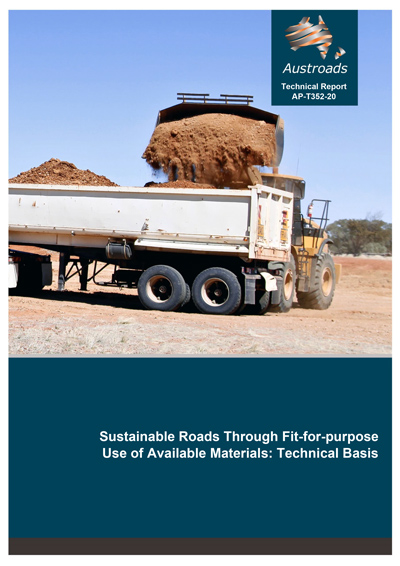Asset Management

Sustainable Roads Through Fit-for-purpose Use of Available Materials: Technical Basis
- Publication no: AP-T352-20
- ISBN: 978-1-925854-92-3
- Published: 11 March 2020
- PDF (free) Download
This report documents the findings of an Austroads project which aims to encourage sustainable roads through fit-for-purpose use of available materials.
The research addressed the use of marginal and non-standard materials in both sealed and unsealed road pavements.
This report documents the evidence and justification for the development of the user assessment process or guidance document which aims encouraging fit-for-purpose use of available materials for sealed and unsealed road construction and maintenance, including renewal of low to medium level traffic roads.
It covers:
- the context and definition of fit-for-purpose material use
- the effect of material, traffic and climate on fit-for-purpose outcomes
- predicting and controlling performance
- the development of a sealed and unsealed roads material risk assessment and corresponding assessment criteria
- risk management techniques for increasing fit-for-purpose material options
- background discussion about life-cycle costs (LCC) and the components which feed into an assessment.
- Summary
- 1. Introduction
- 1.1 Background
- 1.2 Scope and Purpose
- 1.3 Purpose of This Document
- 1.4 Structure and Contents of This Document
- 2. Fit-for-purpose Material Use
- 2.1 Context and Definition
- 2.2 Life-cycle Cost
- 2.2.1 Required Capital Investment
- 2.2.2 Ongoing Investment
- 2.3 Aspects Determined by Material
- 2.3.1 Pavement Performance and Risk
- 2.3.2 Stabilisation/Modification Requirements
- 2.3.3 Moisture Limiting Design Requirements
- 2.4 Aspects Determined by Traffic
- 2.4.1 Pavement Design
- 2.4.2 Road Importance and Level of Service
- 2.4.3 Performance Criteria
- 2.4.4 Functionality Requirements
- 2.5 Aspects Determined by Moisture
- 3. Predicting and Controlling Performance
- 3.1 Proposed Inputs
- 3.2 Risk Catalogue
- 3.3 Material Characteristics
- 3.3.1 Material Types
- 3.3.2 Grading Characteristics
- 3.3.3 Plasticity Characteristics
- 3.4 Performance Mechanisms
- 3.4.1 Traffic
- 3.4.2 Moisture
- 3.5 Sealed Risk Assessment
- 3.5.1 Available Sealed Roads Requirements
- 3.6 Unsealed Risk Assessment
- 3.7 Risk Management Techniques
- 3.7.1 Material Management
- 3.7.2 Moisture Management
- 3.8 Good Practice Techniques
- 3.8.1 Construction Management
- 3.8.2 Ongoing Maintenance
- 4. General Outline of the LCC Framework
- 4.1 Introduction
- 4.1.1 Economic Evaluation of Case Studies
- 4.1.2 Levels of Service
- 4.1.3 PLCC Demonstration Tool for Sealed Roads
- 4.1.4 Road Deterioration (RD) and Work Effects (WE) Models
- 4.1.5 Road User Cost (RUC) Model
- 4.2 Overview of LCC Case Study Tasks for Sealed Roads
- 4.3 Assembling the Case Studies for Sealed Roads
- 4.3.1 Section Definition
- 4.3.2 Pavement Strength
- 4.3.3 Determination of SNC From Layer Properties
- 4.3.4 Determination of SNC From Deflection
- 4.3.5 Estimation of Initial In-service SNC
- 4.4 Example of Predicted Performance Trends for a Sample of Cases
- 4.1 Introduction
- References
- Appendix A Performance Risk Assessment
- Appendix B Case Studies
- B.1 Overview
- B.2 Gascoyne Region, Western Australia
- B.2.1 Overview of Location
- B.2.2 Climate
- B.2.3 Traffic
- B.2.4 Material Properties and Performance Risk
- B.2.5 Fit-for-purpose Assessment
- B.3 Goldfields-Esperance Region, Western Australia
- B.3.1 Overview of Location
- B.3.2 Climate
- B.3.3 Traffic
- B.3.4 Material Properties and Performance Risk
- B.4 Central West Region, Queensland
- B.4.1 Overview
- B.4.2 Performance Trends
- B.4.3 Economic Analysis
- B.4.4 Further Development of This Case Study
- B.5 Cassowary Coast, Queensland
- B.5.1 Overview
- B.5.2 Observed Performance
- B.5.3 Life-cycle Analysis
- B.6 Colac Otway Region, Victoria
- B.6.1 Overview
- B.6.2 Types and Properties of Available Materials
- B.6.3 Investigation of Blended Materials
- B.7 Port Macquarie-Hastings, New South Wales
- B.7.1 Overview
- B.7.2 Results of Desktop Blending Analysis
Related publications
WEB-AAM6164-1
Latest Asset Management News
